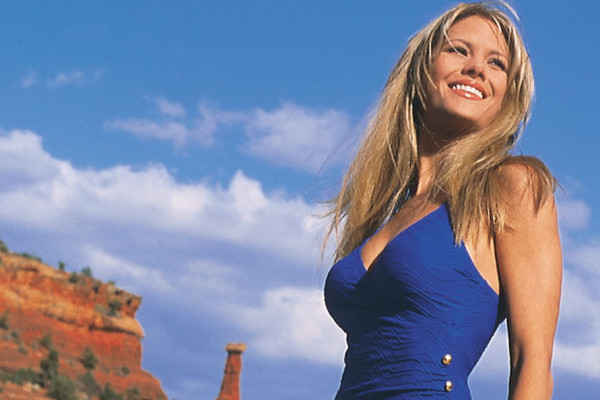Continued (page 2 of 4)
With your gear ready, it’s time to pick a trail. If you’re bringing kids, Gary recommends West Fork (six miles round-trip) in Oak Creek Canyon and Devil’s Bridge (two miles round-trip) in the Seven Canyons area. West Fork gives kids a chance to splash around in the creek while Devil’s Bridge takes you to a neat natural arch.
For more of a challenge, Boynton Canyon is a favorite. Located near Enchantment Resort, the trail (seven miles round-trip) brings you to the back of a box canyon and one of Sedona’s famed vortices. Gary also likes Doe Mountain, which he calls “Sedona’s stair climber.” It stands south of Boynton Canyon and comes out at about 3.5 miles round-trip if you roam the top of the mesa.
For a strenuous, all-day trek, try climbing to the top of Bear Mountain in West Sedona or Wilson Mountain near Uptown. Both provide amazing views of Sedona and Flagstaff’s San Francisco Peaks but it’s an uphill climb: Be prepared for a 1,200-foot elevation change at Bear Mountain and a 2,400-foot elevation change at Wilson Mountain. For a guide to these trails, see Sedona Hikes by Richard and Sherry Mangum (Hexagon Press, $16.95) or Sedona’s Top 10 Hikes by Dennis Andres (Meta Adventures, $11.95).
Temperatures are comfortable for hiking in Sedona most of the year; if you’re here in July/August, start early to get off the trail before it gets too hot.
Canyon Outfitters sells boots, hydration packs, tents, sleeping bags, dehydrated food, hiking poles and maps. Sedona Sports sells equipment and rents hiking staffs, binoculars, GPS units and child backpack carriers.
Wildlife on Sedona trails is relatively rare. Mountain lions do live here, but sightings by hikers are far out of the ordinary. We also have a fair amount of rattlesnakes, scorpions and tarantulas but Gary says he has heard about many more encounters with our thorny flora than venomous fauna.
If you want company, Sedona Westerners leads four weekly group hikes, on trails of varying difficulty and length. The group has 300+ members and has been organizing Sedona hikes for more than 40 years. To learn more, see www.sedonawesterners.com.
Rock Climbing
The Overlook, The Mace, Dr. Rubio’s Wild Ride
Climbing Sedona’s towering red rock spires is a thrill for experienced climbers who come here from all over the world – local climbers count more than 300 routes in our area. But they caution Sedona’s rocks are no place for beginners.
“Most people who climb here have been doing it for five to ten years,” says Glenn Slattery, a 20-year veteran rock climber who leads teambuilding programs for corporate groups through his company, Terra Trax. “The area has a reputation for dangerous climbing because the rocks are loose and the routes are hard to find. But while sandstone isn’t as hard as granite, the surface [sedimentary rock] exfoliates. On the established routes in Sedona, the sediment has been cleaned off to expose hard rock.”
Sedona is part of Coconino National Forest and National Forest law allows fixed anchors to be placed in the rocks so all the established routes have them, generally at the base of climb and at the top. Climbers use these anchors as well as passive camming units – designed to fit into cracks and crevices in order to hold a climber’s fall – rather than pitons that sit permanently in the rock. The final climber in the group removes the units as he or she proceeds up the rock. This form of climbing is referred to as traditional, or “trad” in climbers’-speak. Sport climbing refers to climbs which use bolts permanently placed in rocks to get to the top. Once they reach the top, trad climbers repel back down using a series of ropes.



